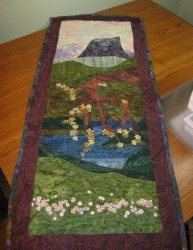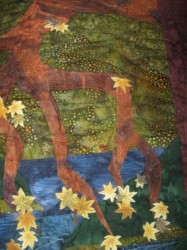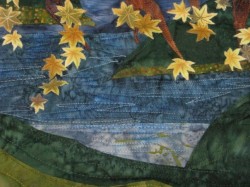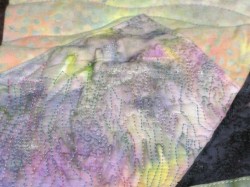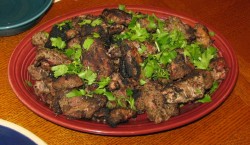The Importance of Vitamin D
I haven’t posted for a few days because I have been in miserable pain for about three days now and have had trouble sleeping because of it. So my usual ability to string together coherent, and at times, aesthetically pleasing sentences has been at an all-time low.
However, I finally got to see my doctor and found out the results of the huge array of blood tests she ordered about three weeks ago.
It turns out that my glucose tolerance is great, my liver is fine, kidneys are fine, I have elevated HDL cholesterol (which seems to be a genetic predisposition) and my B12 levels are great. (All those whole grains and leafy greens.) The thyroid seems to be fine, gallbladder is great, and all of that.
There were two troubling abnormal levels. One was my sedimentation rate was slightly elevated, indicating that there was inflammation somewhere in my body (as my doctor said, “The fact that you are in constant pain tells us that!) and the other was my vitamin D level. It was very low. Incredibly low, in fact, indicating a severe vitamin D deficiency.
Vitamin D is necessary for proper muscle functioning, cell growth and division, and endocrine and brain function.
Symptoms of vitamin D deficiency include muscle pain, spasms and cramps, extreme fatigue, depression, mood swings, brain fogginess and disrupted sleep.
Oh, wow. The exact symptoms that I have.
As Mr. Spock would say, “Fascinating.”
So, I am on a once a week high-dose vitamin D supplement. Dr. Ford, who quite eloquently noted that I could probably sit outside naked all day and not make up the deficiency as fast as I would need to, said that I should start to feel better within a couple of weeks. If the pain does not reduce and my sleep does not improve by then, I am supposed to call her. We will continue the supplementation, but we will also look into trying to help me sleep better.
Can I say how much I love my doctor? She’s very careful, sensible and sharp–she was way ahead of me when it comes to checking out all of my symptoms and trying to get to the bottom of them. She seems to think that I may have fibromyalgia, especially considering the fact that two family members are similarly diagnosed, but she doesn’t want to make that diagnosis–which is not a clinical one–there is no test to definitively give that diagnosis–until she has carefully checked and rejected all other possible diagnoses. It is still possible that I have fibro which is being exacerbated by low levels of vitamin D, but it is just as likely that it is the deficiency itself which is causing the symptoms. So, she is careful and judicious in her treatment and she is very respectful of the fact that while I am getting really tired of being in pain and weary all the time, she also knows I don’t want to just lightly start taking drugs to try and fix every symptom all at once.
I guess we are a good fit with each other.
Now, let’s talk about vitamin D again–interestingly, it was a longtime reader here at Tigers & Strawberries who sent me email telling me about the effects of a deficiency. Maureen–I don’t think I ever emailed you back and thanked you, but thank you–though I never got a chance to tell my doctor to test my vitamin D levels because she was already on the case and had ordered the test along with every other test in the world! She is a sharp one–up on the latest research and all!
And she told me the same things that Maureen told me–that vitamin D deficiency causes the exact symptoms from which I suffer. So, thank you again, Maureen!
I will close this post with an appeal to my readers. If you suffer from chronic pain and fatigue, please ask your doctor to check your vitamin D levels. You may be deficient, and if you are, it is easily enough corrected. A lot of research is currently ongoing which points to the importance of vitamin D in the proper functioning of our bodies and many of these studies have shown that a great many Americans have low levels of vitamin D in their bloodstreams. The long term effects of such a deficiency can be severe and serious–elevated cholesterol levels leading to cardiovascular disease, cancer, and osteoporosis among other nasty conditions and diseases.
I wonder why so many folks seem to be suffering from vitamin D deficiency. It could be that The American Cancer Society has succeeded all too well in their message to use sunscreen in order to avoid melanoma, or it could be that Americans have become sedentary house-dwellers who rarely go outside. Or it could be both.
Or, it could be diet-related–folks may not be eating many eggs for fear of high cholesterol, or fatty fish for fear of mercury poisoning, or milk because of a fear of fat.
It is puzzling, though.
Anyway, we will see what happens. I will report back on how I feel here after two weeks of mega dosing on prescription-strength vitamin D. In the meantime, I will keep eating my leafy greens, eggs and go back to drinking milk while I am at it, and will endeavor to be out in the sun as much as someone as pale as I am can be safely. (A tip for those of us who are very pale–sunscreen free sunning is safer in the morning and evening hours–when the sun is at its peak between the hours of 11 am and 2 pm, please cover up or wear sunscreen or go inside.)
The Landscape Quilt Is Finished
I finished my first landscape quilt Thursday night, in a flurry of hand-stitching. The binding, the hanging sleeve, and the label, the one that identifies it by its title, my name, and the date, all are sewn by hand. I was surprised at how quickly I could stitch all of it.
Then, yesterday, afternoon, I took it, along with two other quilts I had made already, and hung them as part of a show of art quilts at Casa Nueva. I was so excited to be a part of the show–it had rather fallen into my lap. One of the servers at Casa is an art quilter, and she was organizing the show to coincide with the Dairy Barn’s Quilt National show–an annual juried art quilt exhibit where quilters from all over the world can show how they combine tradition with innovation, expanding horizons of the quilt as an art form.
Here are a few photographs to show details from my quilt. It’s hard to see the stitching without looking closely.
And it is hard to see the tiny moose button I added–I have it situated so that the moose looks like he is wading in the shallows across the lake.
I was inspired by the traditions of Japanese landscape art–particularly the works of Hokusai–when I sketched out the design for this quilt. I always liked the way he made the human figures very small in scale, making them details in the landscape, not the focus of the landscape. That was sort of what I was doing when I added the moose–I wanted to give the feeling of a living creature in the landscape, who is there as part of the natural world, but isn’t the focal point of the piece.
I hand-colored the Japanese maple leaves; they were originally greyish-brown and beige, so I added greens, a touch of yellow and highlights of orange and coral. I used Prismacolor colored pencils–after you use them to color on fabric, you iron over it, and this heat-sets the color and makes it permanent.
The quilting on the branches was fun; I liked rendering the details of the bark in stitches–getting the feeling of rough texture with shapes that are by turns undulating and angular in lines that are very close together.
I had a great deal of fun with the water; first of all, I layered three different hand-dyed and batik fabrics to make the basic shape and color of the lake; then I added iridescent blue oil paint in the form of Shiva paintsticks to blend the colors and add shimmering highlights.
Then, using two different threads–a dark blue shimmering rayon and a heavier-weight cotton quilting thread in variegated blues, I quilted straight lines and zigzags to show the movement of wind on water.
And then there were the mountains, which were actually the second part of the landscape I quilted. I loved making the look of rocky crags and outcroppings using multi-colored heavy quilting thread–it really made the mountains come to life.
I had so much fun with this first landscape, I am inspired to make more of them. I love quilting in many different forms, but I had so much fun with this quilt–I worked on it intensely, a little every day for three weeks. I have an idea for another couple of landscapes–deserts, trees, mountains–and even some psychedelic, dream-like visions, and I can’t wait to start another one!
As Susan from the Nelsonville Quilt Company said, “I think you’ve found your calling!”
I’ll take a photograph or two of my quilts hanging at Casa and post them next week! For folks in and around Athens, they will be displayed there for the next month.
And then, Marsha tells me that we are going to be hanging quilts again in July, so I want to make another couple of new pieces by then!
By Popular Request: My Favorite Jerk Rub Recipe
So, yesterday, I posted my version of Jamaican “peas and rice,” which is what most Americans would call red beans and rice. Whatever you call it, it is tasty–in fact, probably the tastiest beans and rice ever.
A couple of readers asked for my jerk rub recipe, and so here is my favorite–the one that I have developed over the past decade or so.
Last year, I published two variations of jerk rub. I really love the Japanese-Jamaican version, and I used the basic recipe for it to create this variant, which I think is my favorite of all time. It has more black pepper in it than the other version, more garlic and some cumin.
Cumin is so totally not traditional, but I find that when it is judiciously used, it really enhances the meaty flavor of whatever it is used on it. I wonder if it has natural glutamates in it?
If you are more interested in a traditional jerk recipe–try the first one on the link above. It is pretty truly traditional.
But this one, while untraditional and inauthentic in the extreme, is pretty amazingly good, and while it makes great seasoning for pork tenderloin medallions, it also rocks on chicken. I can’t wait to try it on lamb, bison and venison, too.
Barbara’s Favorite But Not Traditional Jerk Rub/Marinade
Ingredients:
1 1/2 heads garlic, peeled and finely chopped
1 cup very finely minced scallion, both green and white parts
3 tablespoons fresh thyme leaves
2″ cube fresh ginger, peeled and minced
fresh chili pepper, minced–to taste (scotch bonnet or habanero are traditional, but I have used Thai chilies to good effect)
1 teaspoon whole peppercorns, freshly ground
2 tablespoons whole allspice berries, freshly ground
5 whole cloves, freshly ground
1/2 teaspoon cumin seeds, freshly ground
1/2 teaspoon ground cinnamon
1/4 whole nutmeg, ground
1/2 teaspoon salt
1 tablespoon tamari soy sauce
1 teaspoon toasted sesame oil
1/4 cup pineapple juice
2 tablespoons lime juice
2 1/2 tablespoons canola or peanut oil
Method:
Mix everything together until you have a kind of chunky greenish brown paste. It will be quite fragrant, but in a good way.
Rub it all over whatever meat you are using–I like to cut my meat into small pieces for cooking, because you get more surface area to get the spice rub on for more flavor–but it is up to you how you do it.
Let it sit, well covered, in the fridge however long you like–up to overnight. Bring to room temperature before throwing it on the grill. Grill on a hot fire for however long it takes for whichever meat you use to get done. The meat should be crispyish on the outside with some nice browned crackly spots and juicy and tender inside.
You can make jerk rub up ahead of time and freeze it in an airtight container–I like doubled ziplock bags to keep the fragrance in–and it will keep for about six months.
If you would rather make a pourable marinade out of this, add more pineapple or lime juice and a bit more canola or peanut oil.
The Tastiest Beans and Rice–Jamaican Style!
I love beans and rice.
Which makes sense–when I was growing up, I loved rice. I begged Mom to make rice all the time, and even though all she knew how to make was Minute Rice, I still loved the stuff. Now, of course, I eat rice all the time, and not that weird instant business, but real rice.
And I grew up eating dried beans all the time, because they were cheap and filling and tasted great. Cooked southern style with a ham hock or jowl bacon or a ham bone or whatever, beans were the go-to meal when Mom needed to stretch the food budget. In fact, the year that Dad was laid off from Carbide, we ate beans two or three times a week. Which was fine, because they tasted great. We ate a lot of pinto beans, but also navy beans, big lima beans, baby lima beans and in our chili, we had deep red kidney beans with tough skins and velvety insides that melted on your tongue like cream.
When I finally tasted Cajun-Creole red beans and rice in my college years, I fell totally in love. Two of my favorite foods mixed together in a bowl, with Andouille sausage, garlic, onions, sweet peppers and whoo-boy–chilies to jazz it all up and make it ready for the palate. For years red beans and rice was my favorite meal, but then I picked up a copy of a great cookbook on sale here in Athens years and years ago that changed my life. It changed the way I grilled forever, and it has helped shape my continued love of beans and rice.
It was Helen Willinsky’s Jerk: Barbeque From Jamaica, and I urge you to get it and cook from it. It is out of print, but you can get copies of it used all over the place including on Amazon. It isn’t a pretty cookbook with lots of photographs–the only illustrations are some woodcut bits at the beginning of each chapter–but it doesn’t matter. Willinsky’s words carry the day, and describe food that even though I had never eaten it in my life, made my mouth water. I nabbed it and took it home and have been cooking with it ever since–my copy is battered with dog-eared pages, and mysterious stains on the cover and smeared across recipes that even now, years after the accidents that marked them, smell delectably spicy. (Jerk marinade lasts a long time, apparently.)
Now, here is the deal–if you want, you can get the updated version of the book: Jerk Jamaican Style also by Willinsky, which has a few more recipes, and lots and lots of really great photographs of the food and people of Jamaica, and for folks who need visuals, it is a great alternative. The truth is, I have both books–I bought the new one to review and ended up keeping them both because I just loved them so much. But I think I like the funky original one better, because it is a testament to Willinsky’s vivid writing that it captured my attention in the dimly-lit corner of a little bookstore in Athens, Ohio, and caused me to take it home and start cooking a cuisine I knew nothing about and had never tasted. Besides, if you get a little greasy bit of marinade on it, you won’t feel as bad as if you messed up a pretty book.
Or at least, I wouldn’t.
Now, I have been cooking jerk and its accompaniments for so long, I don’t use Willinksy’s recipes as written at all–I have my own variations, which is the way of all cooks. I make jerk my way, and it is a very tasty way. I also make Jamaican red beans and rice my way–or as they say in Jamaica, “peas and rice” and I like my way a lot better than Willinsky’s. It may not be exactly authentic, but it sure tastes amazing, and for that alone, I think it is worth sharing the recipe.
Now, there is pork in this recipe. A ham hock and some bacon fat. But, if you are a vegetarian or a Muslim you can leave that out and still get a great tasting bean and rice experience. You just have to make these substitutions. For the ham hock, if you are a vegetarian add about a tablespoon of Smoked Spanish Paprika. Add it after you have browned the onions, peppers and garlic, and stir it for a minute or two in the hot fat.
If you are a Muslim, use a smoked turkey wing, which you can find at a lot of grocery stores these days. (You can also do that if you are worried about lots of animal fat–the turkey wing is way lower in fat than the ham hock and is almost as tasty.) And for the bacon fat, you can substitute butter or olive oil–whichever floats your boat, whether you are a vegetarian or a Muslim or you just cannot abide the idea of cooking with bacon fat for whatever reason.
Now, lets talk about the red beans. I am not using big red kidney beans in this recipe, but instead am cooking small red beans. I can get them at Kroger easily, as well as from the Whole Foods. You can also get them cheap at Mexican, Caribbean or Latin-American grocery stores, or you can order them online. (The best place to get them are the Mexican, Caribbean or Latin American stores–they have the best prices.)
Small red beans have a softer texture than kidney beans and don’t taste the same. They taste–beanier–I guess you would say. Meatier or something. Kidney beans have a sweetness to them that the small red beans lack, and I think that is a good thing. I prefer kidney beans in chili or rajma dal. For any red beans and rice application, I am all about the small red beans.
I cook this recipe in my pressure cooker, but you can just cook it in a regular pot on your stove all day. It just takes longer, and I’m impatient is all. But you don’t have to be–if you cook the beans all day, you get the added benefit of your whole house smelling delicious for a day or two afterwords. But if you are a fast-paced personality or you don’t have all day to cook, invest in a pressure cooker and be amazed at how fast you can make dried beans, dals, curries, soups, stews and pot roasts that taste exactly as if you spent the entire day on them, all with excellent textures to boot. (Pressure cooking makes beans even velvetier and meat amazingly tender.)
There is coconut milk in this recipe, and you can use a variable amount in it. I prefer the 19 ounce cans of Mae Ploy coconut milk in this recipe, and you can use one or two cans of it in your beans. (Don’t worry about the price listed on this link–it is cheaper other places–I just put this link here so you could get a good look at the can. It is about 99 cents to a 1.25 per can at my local Asian market.) I usually use two cans, but I only had one this time around and so the beans ended up a little less rich, but still damned fine and tasty. They just lacked a little in the coconut flavor and Zak missed that, so next time, it will be two cans again.
Finally, the Jerk seasoning–I always make these beans to go with Jerk, so I add a tablespoon or two of my just made jerk rub to the pot. That is easy. But what if you aren’t making anything jerk when you make the beans.
Be not afraid, you can still have beans. Get yourself a jar of Walkerswood Jerk Seasoning paste and you just add a tablespoon or so of that to your pot of beans and go on with your bad self.
Oh, and while you are cooking, listen to one of my favorite Spearhead songs–Red Beans and Rice. It’s an awesome song that I am singing in my head right now as I type out the recipe.
Jamaican Style Red Beans and Rice
Ingredients:
2 tablespoons bacon drippings plus1 tablespoon olive oil (or 3 tablespoons olive oil)
2 cups diced onions
1 cup diced red sweet bell pepper
8 large garlic cloves, peeled and mince
2 teaspoons dried thyme
1 teaspoon smoked Spanish paprika
freshly ground black pepper to taste or 1 tablespoon Aleppo pepper flakes
1 ham hock or 1 smoked turkey wing or 1 tablespoon smoked Spanish paprika
1 or 2 19 ounce cans Mae Ploy coconut milk
1 whole scotch bonnet pepper or habanero –optional
1 pound dried red beans, picked over, rinsed and drained
water as needed
1-3 tablespoons jerk rub, marinade or seasoning (the amount depends on how hot your seasoning is with Scotch Bonnet Pepper)
salt to taste
1 tablespoon fresh thyme leaves
1 cup scallion tops, dark green parts only, thinly sliced
1 cup cilantro leaves, roughly chopped
cooked long grain rice–I used about six cups of it–measured -after- cooking
Method:
Heat bacon drippings and or olive oil over medium high heat in pressure cooker or regular pot. Add onions and sweet pepper, and cook, stirring, until the onions turn golden. Add the garlic, dried thyme, paprika and the black pepper or Aleppo pepper flakes, and continue to cook, stirring, until the onions turn brown, the peppers brown on the edges and the garlic turns golden. Add the ham hock and cook for a minute or two, turning the hock once or twice. Add the coconut milk, the optional chili pepper and the dried beans. Stir, and if necessary, add water to cover the beans with at least 2 inches of liquid above the top of the beans. (2 1/2″ to 3″ of water over the beans is better.)
Bring to a boil, cover up the pressure cooker and bring to full pressure. Turn down heat to low and cook for 40-45 minutes on high pressure. Quick release pressure, open the cooker and test the beans for doneness. The skins should split easily when you blow on them and the beans themselves should be soft and meltingly tender without falling apart when you touch them. (If you have no pressure cooker, cover beans loosely with lid, turn down heat and simmer the beans until they are done–which will take anywhere from three to five hours depending on how hot your stove is and how fresh the dried beans are. Stir now and again and add water as needed to keep the beans from sticking.)
Once you have determined that the beans are done, fish out the ham hock, add the jerk seasoning and turn the heat up on the stove. Leaving the pot uncovered, and stirring often, boil off the excess water. The sauce should reduce until it is thick and will cling to the back of a spoon without dripping off easily. Season to taste with salt and stir in the fresh thyme, scallion tops and cilantro leaves. Then, stir in the rice, until the sauce, rice and beans are completely combined.
Note–if you cook this in a pressure cooker, the ham hock may fall apart. If it does, you can fish it out in pieces. Take out the bones, skin and fat for sure, but if you want and if the meat is tender enough to shred easily, you can just stir the lean meat into the beans to make the dish even tastier. (This is the way it happened when I made the dish this time–and let me tell you, it made the beans so good that Dan said they were the best beans and rice he had ever had–and he has eaten a lot of beans and rice. You also have the added benefit of not wasting the meat.)
I Just Have To Brag
I just have to have a proud Mom moment and brag here for a little bit.
Morganna, whom you can see there on the left, with her really cute new haircut and color–black looks ever so natural on her and brings out the warmth in her skin tone–has a new job.
She is the newest line cook at Latitude 39, the fine dining restaurant in Ohio University’s Baker Center. She is thrilled, because all of the stocks, dressings, soups, sausages, sauces, and preserves are made in house, and many of the meats are house-cut. She is thrilled to work with the very experienced, creative, knowledgeable chefs and she looks very much forward to learning as much as she can from them.
I am so proud of her! This is a big leap forward in her career and life path and she did it all herself–with only a little help from her Mom. (I gave her the Executive Chef’s email address–that is all! She did the rest!)
Congratulations, Morganna, for taking that big step forward, and not looking back.
Powered by WordPress. Graphics by Zak Kramer.
Design update by Daniel Trout.
Entries and comments feeds.

